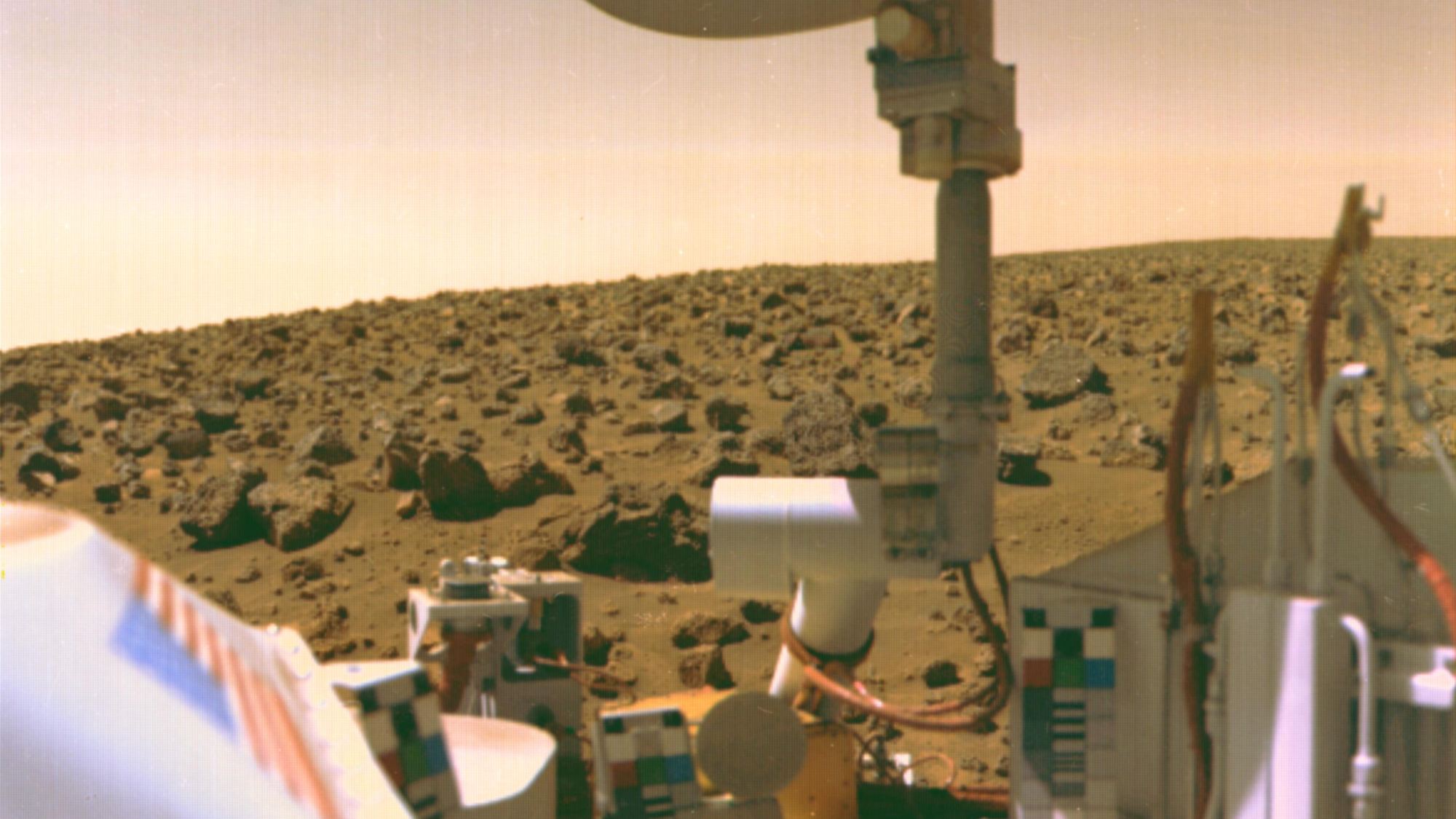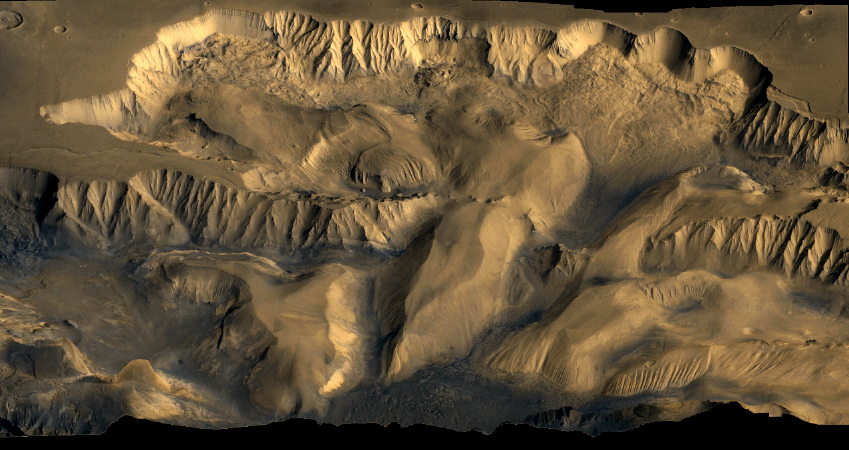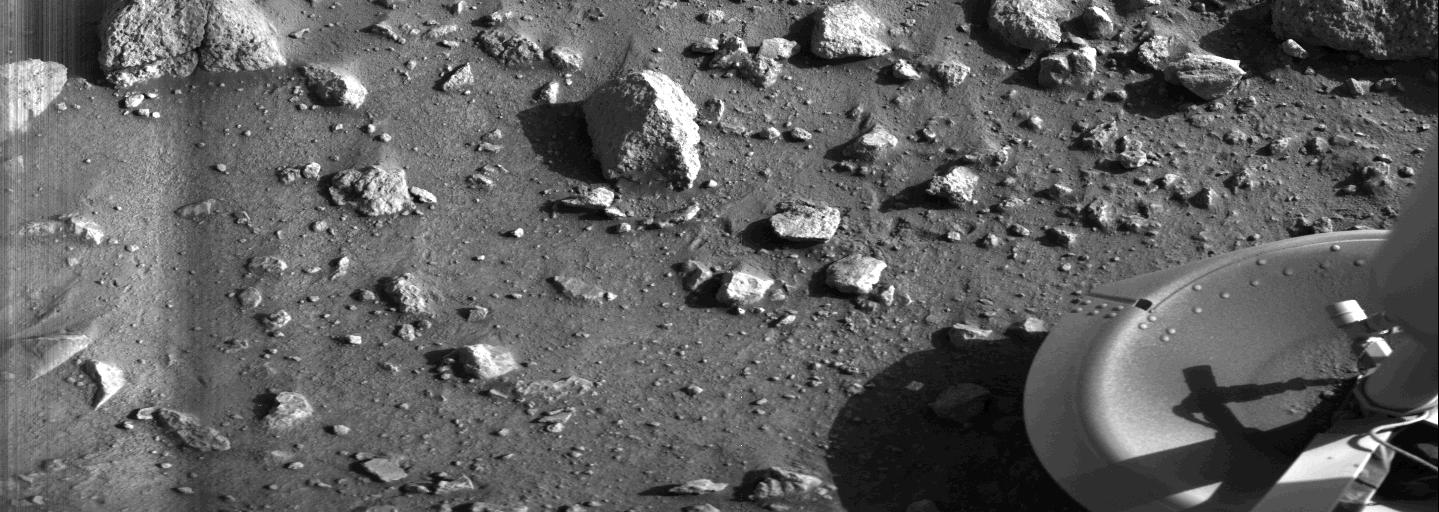Did NASA's Viking landers accidentally kill life on Mars? Why one scientist thinks so
"We’re ultimately looking to discover life, and to do so, we have to think outside the box."

In 1975, NASA's Viking 1 spacecraft entered orbit around Mars, carrying a mission to unlock the secrets of the Red Planet. Soon, it released twin landers that drifted toward the Martian surface and eventually made history as the first American spacecraft to touch down on the world.
For over six years, Viking 1 continued to orbit Mars' Chryse Planitia region while its landers collected soil samples using robotic arms and onboard laboratories, marking a groundbreaking chapter in humanity's exploration of the Martian environment.
At the time, however, little was known about environmental conditions of the Red Planet, and the Viking life detection experiments were modeled after culturing techniques commonly used to identify microbes on Earth. These methods involved adding water and nutrients to those aforementioned soil samples, then monitoring for any signs that suggest microbes might be living in the samples. Such signals were associated with responses to the additives — essentially an influx of components needed to complete normal life cycles as we know them — and included things like growth, reproduction and the consumption of food for energy.
One day, both Viking landers reported a potential positive detection of microbial activity in their soil samples, and the findings naturally sparked decades of intense debate. Had we finally found proof of life elsewhere in the universe? However, most scientists now believe the results were negative or — at best — inconclusive. They think it's more likely that the positive readings have an alternative explanation.
According to Dirk Schulze-Makuch, an astrobiologist at the Technische Universität Berlin in Germany, there may be another facet to this mystery that hasn't yet been considered: Viking may indeed have discovered life on Mars, but the water-based nature of its life-detection experiments might have unintentionally killed it.
In a recent commentary published in the journal Nature Astronomy, titled "We may be looking for Martian life in the wrong place," he argues that because Mars is even drier than one of the most arid places on Earth, the Atacama Desert, where microbes obtain water through salts that draw moisture from the atmosphere, any analogous Martian life would be highly sensitive to the addition of liquid water. Even one drop too much could threaten their existence.
Get the Space.com Newsletter
Breaking space news, the latest updates on rocket launches, skywatching events and more!
Yet, the Viking experiments were conducted under the assumption that Martian life would require liquid water, like most life forms on Earth. Thus, Schulze-Makuch believes, the results of the experiments might be best explained not as the absence of organic life, but as the human-driven destruction of arid microbial organisms exposed to too much water.
If the assumptions about organisms thriving in Mars' hyperarid conditions are accurate, Schulze-Makuch argues that NASA should rethink its longstanding "follow the water" strategy for finding life beyond Earth. Instead, he suggests adopting a "follow the salts" approach.
Space.com sat down with Schulze-Makuch to discuss this intriguing take on the Viking experiments, how the community has reacted to it, and what it might mean for life-seeking experiments going forward.
The interview has been edited for length and clarity.

What sparked your interest in re-examining the Viking experiments on Mars?
I’ve always been intrigued by the Viking life detection experiments. It's unfortunate that they haven’t received more emphasis because, ultimately, they're the only direct life detection experiments we've conducted on another planet. And yes, the results were confusing, but for scientists, that kind of ambiguity is fascinating — it usually signals that there's something deeper to understand.
Now, nearly 50 years later, we can reexamine those experiments with a much better grasp of Mars' environment — its complexities — and how certain reactions could unfold there. We've also gained invaluable insights into extremophiles on Earth — organisms that survive in the most inhospitable conditions — and how they function. That knowledge helps us interpret the Viking data with a new perspective.
Why do you think the Viking experiments might have actually encountered and inadvertently killed Martian life?
I did a lot of work in the Atacama Desert, which is an analog environment to Mars. And we got some “Blues Clues” about how organisms survive there. From there, it wasn't that difficult to put it together.
I presented this idea about a year ago at a special meeting on life in the universe, hosted by the King of the Netherlands. Many European Space Agency scientists were there, and I thought afterwards I may get some backlash, but they took it surprisingly well.
The science concept in this case is that salts, and organisms with the help of the salts, can pull water directly from the atmosphere. There’s also an effect where, as water is removed, there’s a sort of delay — a hysteresis — because the system resists crystallization. This means water can remain in a salt longer than expected, which is crucial because it raises the water activity on a microscopic level, making it accessible to microbes. Life is very good at taking advantage of these physical or chemical effects. There are plenty of examples in biology, which is very good at using these kinds of effects — I’d nearly call them tricks because they're using this kind of quirky physics or chemistry.
Of course, I can’t say there’s definitely an organism on Mars exploiting these effects. But Mars, almost 4 billion years ago, was so much like Earth, with abundant water. As it became drier, moving toward its current desert state, these are the kinds of adaptations I’d expect any remaining life to develop.
How do organisms in Earth's deserts survive by pulling water out of the salts?
It is the same thing if you think about rice in a salt dispenser, where the rice grains are inside to keep the salt dry — otherwise it would become all clumpy. The rice grains are more hygroscopic than the salt grains, so they attract more water from the atmosphere.
It’s the same thing we see in the Salars, where ancient salt lakes dried up, leaving behind salt deposits, but there is still a little moisture in the atmosphere above these deposits. Depending on the type of salt, it can attract and absorb moisture. We call this process hygroscopicity, and it allows the salt to become damp, eventually forming a brine, which is then called deliquescence.
We see this even with common table salt — it can draw in enough moisture from the air to create a brine, in which certain bacteria thrive, even in fully saturated sodium chloride solutions. While more complex salts like perchlorates or chlorates are tougher environments, some organisms can tolerate fairly high concentrations. The main salt on Mars appears to be sodium chloride, which means this idea could work.

Do you believe the assumption that life requires water hinders our understanding of extraterrestrial life and how we look for it?
In general, I would agree with that — but not for Mars. Mars and Earth are so much alike, and you have a lot of the same kind of minerals, though not the same variety on Mars that Earth has because there are a lot of minerals on Earth that are formed by biology. But they are otherwise very, very similar.
They are both terrestrial planets, somewhat similar in their distances away from the sun. If we expect life on Mars, we would be expecting that dependence on water as well. I think if you would look for life, for example, on Titan, where surface conditions vary greatly, then I would agree that this requirement for water would hinder our search. But for Mars itself, I don't see a problem.
How might the Viking experiments have led to a false negative result that life doesn't exist on Mars?
Imagine something similar happened to you [as a human]. For example, if there was an alien in a spaceship coming down to Earth and found you somewhere in the desert. Then they said 'OK, look, that's a human and it needs water,' and puts you directly in the middle of the ocean. You wouldn't like that, right? Even though that is what we are. We are water-filled bags, but too much water is a bad thing, and I think that's what happened with the Viking life-detection experiments.
There was one study done in the Atacama Desert where there was torrential rain and it flooded a huge area. Afterwards, the scientists found that 70-80% of the indigenous bacteria died because they couldn't handle that much water so suddenly. This really fits into the same picture.
How would you design a new experiment that would take this into account and could maybe detect these life forms?
I think the most important thing is that one experiment on its own cannot allow us to make a decision. For example, one might assume that Martian organisms have exactly the same DNA as those on Earth, and so we might devise an experiment to go looking for that material. But what if it’s different? You would then have to have several different experiments to test this out and make a sure conclusion.
In the case of the Viking life-detection experiments, these people were not stupid and I think the approach was right at that time, but the scientists didn't really know anything about the Martian environment. What they were doing was very sophisticated for the time. And now, we have much better tools and much better insights and better methodologies.
I think, from my perspective, the key is not to rely on one experiment to make a conclusion. My research group, for example, is currently working on live detection based on motility, the characteristic movement of microorganisms, which also uses water by the way, but in very small amounts. We look at how the organisms or the sediment particles move in the drop of liquid, for example. If it's a bacterium, it has a certain kind of pattern that depends on the kind of bacteria and can be distinguished from a sediment particle because a sediment particle would move differently. With AI, we can track the movement automatically to say this is a microbe, and that is a sediment particle. We think that we can distinguish even an alien microbe from a sediment particle. That might be an interesting experiment to conduct.
The point is, there are numerous ways to [search for life on Mars]. Ideally, it would be nice to have a microscope on Mars, but this poses challenges — though I think it’s getting to be about time that we use one for searching for life on other planets.
But to make a long story short, we would want to have several different kinds of life-detection methods that are independent of each other, and from there, we could come up with more convincing data.

Have you observed a shift since Viking in how scientists are looking for life on Mars? Have the methods evolved a bit or taken this into account?
Yes, there are lots of different methods available now and there are, of course, advantages and disadvantages to each. Gas chromatography and [mass spectrometry] is one of the more sophisticated [methods] and would allow scientists to look at the organic compositions of samples.
We could then compare to samples from Earth. For example, you would see specific patterns and peaks for certain proteins and their amino acids — these we know and could expect. You could also look for products of abiotic synthesis, the kind that happens in the beginning, before life, and would be indicative with high levels of small organic molecules.
Essentially, we do have quite a few methodologies that would be really interesting to test out.
In the context of this hypothesis, what specific salts or mineral compositions could be prioritized? You mentioned sodium chloride, but are there any others?
Yes, you’d need to look for hygroscopic salts. Not all soils possess this property; for instance, some sulfur salts, like gypsum, are not hygroscopic as the mineral structure contains a lot of water and would not be suitable.
Sodium chloride is probably the most common choice, along with potassium chloride. In my research group, we're also looking at chlorates and perchlorates, which we’ve found to be quite effective. Chlorate (ClO₃) and perchlorate (ClO₄) are the types we're interested in, although perchlorates can be a bit problematic for life as we know it; they can be tolerated only in certain amounts, and too much can be harmful. On the other hand, chlorates seem to work much better.
One advantage of chlorates and perchlorates is that they stay liquid at much lower temperatures compared to sodium and potassium chloride. That’s significant because if the environment gets really cold, having salts that remain liquid at colder temperatures could provide a more suitable habitat for microbial life.
So, while sodium chloride is a top priority, I’d also suggest considering chlorates and perchlorates. In regions like the Southern Highlands of Mars, high concentrations of chloride have been detected.
Do you think this take is controversial?
Yes, surely it's controversial. In science, challenging the prevailing paradigm is always tough. Colleagues often review work from a position that reflects their existing beliefs, and egos can complicate the process as well. Ultimately, though, I believe science prevails. There isn't a top-down approach; even the most esteemed scientists can be wrong, and we all understand that. My aim has always been to present our findings and let the scientific community engage with them as potential hypotheses.
But it’s important to put out a hypothesis out to see if we can come up with a logically sound solution to it. I do not know whether there are really microbes on Mars, but I feel confident that my proposed solution could work and might reveal life. Future missions should definitely investigate this further. I might be wrong, but I could also be right — we won’t know until we try.
Eventually, we will get the evidence, one way or another, and that's good. I’m ok if I was wrong. I think either way, this was an interesting idea — even if some people don't think so. But we’re ultimately looking to discover life, and to do so, we have to think outside the box.
Join our Space Forums to keep talking space on the latest missions, night sky and more! And if you have a news tip, correction or comment, let us know at: community@space.com.

A chemist turned science writer, Victoria Corless completed her Ph.D. in organic synthesis at the University of Toronto and, ever the cliché, realized lab work was not something she wanted to do for the rest of her days. After dabbling in science writing and a brief stint as a medical writer, Victoria joined Wiley’s Advanced Science News where she works as an editor and writer. On the side, she freelances for various outlets, including Research2Reality and Chemistry World.
